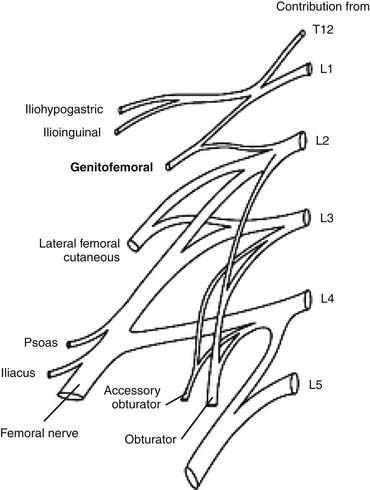29 Genitofemoral Neural Blockade
Clinically Relevant Anatomy
The genitofemoral nerve stems from the lumbar plexus. The lumbar plexus is formed by the ventral rami of L1 through the greater portion of L4. The ventral ramus of L1, which is frequently joined by a branch of T12, bifurcates into upper and lower portions (Fig. 29-1). The upper part divides into the iliohypogastric and ilioinguinal nerves as the lower part unites with a branch of the L2 ramus to form the genitofemoral nerve. Although much variation exists,1 the genitofemoral nerve often penetrates the psoas major muscle to then divide into a genital and femoral branch.

Figure 29-1 Lumbosacral anatomy of the genitofemoral nerve.
(Image courtesy of Dr. Alvin K. Antony.)
The genital branch, or external spermatic branch, is in part responsible for the cremasteric reflex by supplying the cremaster muscle. This genital branch traverses the internal inguinal ring to descend adjacent to the spermatic cord to supply the skin of the scrotum in males. In females, it accompanies the round ligament of the uterus2 to ultimately innervate the mons pubis and labia majora.
Descending on the external iliac artery and passing deep to the inguinal ligament, the femoral branch (or external lumboinguinal branch) enters the femoral sheath where it travels until it pierces the anterior layer, as well as, the fascia lata as it exits to supply skin sensation.2 Here the femoral branch supplies the skin with sensation at the anterior aspect of the femoral triangle, which is bordered by the inguinal ligament and the adductor longus and sartorius muscles.
All three of the “border” nerves (the iliohypogastric, the ilioinguinal, and the genitofemoral nerves) can cross-communicate to some extent. The exact origin, course, and distribution of each individual nerve are difficult to distinguish because communication between branches exists and a high degree of variability is present.1 This cross-communication phenomena should be noted, especially if difficulty achieving successful neural blockade is experienced.
Etiology and Pathogenesis
Genitofemoral neuralgia was first described in 1942.3 Injury to the genitofemoral nerve is almost always secondary to direct trauma. Direct trauma is almost always the result of surgery. Complications following inguinal herniorrhaphy4–11 and laparoscopic varicocelectomy12–16 are cited relatively frequently and can stem from inflammation, neuroma formation, deafferentation, or entrapment.4 Entrapment neuropathy can occur from impingement from staples or tacks which are used to affix the prosthetic mesh,17,18 the mesh itself, direct injury, or myofascial scarring.19
Additionally, it is not uncommon for genitofemoral neuralgia to be induced during performance of a lumbar sympathetic block.20–23 Lumbar sympathetic blocks, which are traditionally performed by injecting a needle from a posterior position toward the anterolateral aspect of the vertebral body, may allow for the injected solution to leak back along the needle shaft and spread toward the genitofemoral nerve,20 acting as a noxious irritant on the nerve.
Other factors, such as an abscess or mass dwelling within or near the psoas major muscle,19 complications secondary to appendectomy,9 inguinal lymph node dissection, orchiectomy, total abdominal hysterectomy, abdominoplasty, iliac crest bone graft, femoral catheter placement,8 cesarean section,24 thermal damage following radiofrequency ablation of renal cell carcinoma,25 direct injury from an inguinal herniated mass26,27 and complications from leprosy28 have also been noted.
Genitofemoral neuropathy will typically present as a neuropathic type groin pain following the distribution of the genitofemoral nerve. Pain may extend from the femoral triangle at the medial thigh to the scrotum in males or the mons pubis and labia majora in females. Although controversy exists as to which descriptors indicate a neuropathic type pain, adjectives such as “hot, burning, sensitive, and tingling” are frequently used.29
Indications
Groin pain in a genitofemoral neuroanatomic distribution with neuropathic pain features is the main indication for this block. A recent history of lower abdominal or groin trauma or surgery, especially inguinal herniorrhaphy, appendectomy, laparoscopic varicocelectomy, or cesarean section should be noted. Blocks may be used following these surgeries to augment pharmacologic pain control or during an inguinal herniorrhaphy as a local anesthetic.
Genitofemoral nerve infiltration used concomitantly with femoral nerve blocks in outpatients undergoing long saphenous vein stripping have been shown to result in a significantly faster recovery time, fewer complications, superior pain control, and better patient satisfaction when compared to spinal anesthesia.30
Diagnostically, blocks can be used to help achieve a more accurate utilization of further invasive interventions. Following failure of conservative measures of groin pain, a patient’s response to a peripheral neural blockade can be evaluated and, if temporary success is found, neurolysis,31 cryoneurolysis,32 or neurectomy33–35 may be indicated. As noted earlier, it is important to maintain an understanding of the ambiguous, overlapping distribution of the iliohypogastric, ilioinguinal, and genitofemoral nerves in the groin region and a neural blockade may need to be applied to each nerve to achieve successful pain control. Moreover, an MRI, CT, and EMG can aid in determining whether involvement of a lumbar radiculopathy, abscess, or malignancy exists.








